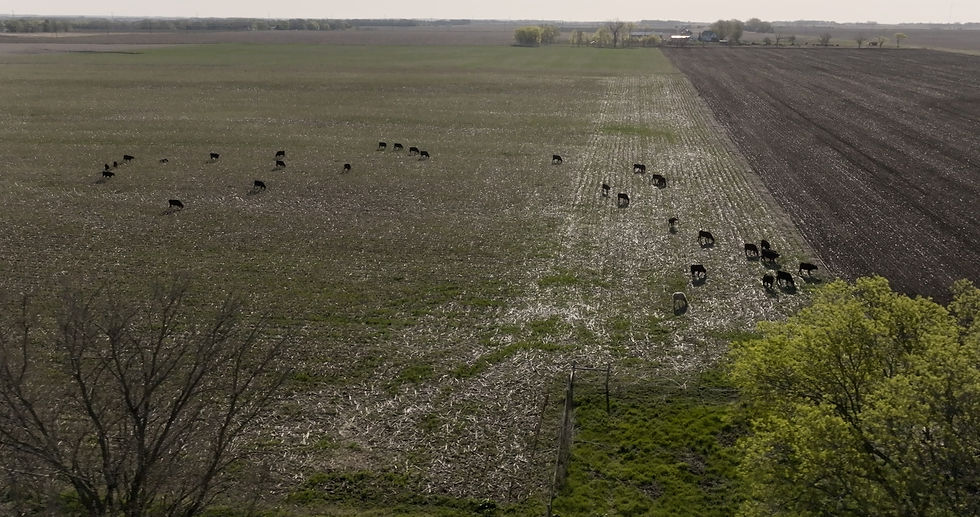Blending No-Till, Cover Crops, and Stocker Cattle: Cody Merrigan’s Regenerative Farming Model in Clay County, SD
- Buz Kloot, Ph.D.

- Jun 24
- 3 min read
By Buz Kloot

An old friend of mine grew up in Utah’s Cache Valley, where his dad, a worn-out dairyman, would shake his head after a long day and mutter, “I sure hope there ain’t no cows in heaven.”
But I’m not so sure anymore—especially after visiting Cody Merrigan, a young farmer just a stone’s throw from the University of South Dakota’s Vermillion campus. Cody runs a mixed operation of row crops, cover crops, and stocker cattle in Clay County, where most folks stick to corn and soybeans and leave the livestock to someone else.
“Other than Mr. Nissen,” he said, “no one else around here does what we do. It’s like living in a bubble.”
On this “island,” Cody is doing something different: blending no-till, cover crops, and stocker cattle in a way that doesn’t just cut inputs—it regenerates the land.
A Journey Sparked by a YouTube Video
Cody didn’t start out with no-till or grazing covers. “I grew up conventional,” he says. But a soils teacher planted a seed, and a David Brandt video on cover crops lit the spark.
“It looked fun. Simple. So I gave it a shot. Planted some wheat and a cover crop. Total failure—no moisture. But I was hooked.”
That curiosity led him to the Ranching for Profit school and the South Dakota Grazing School.
“Every year I’ve gotten better at grazing—on native range, cover crops, everything,” he says. “But it really started with one video.”
A System That Regenerates, Rotates, and Flexes
Cody's system is built on keeping living roots in the soil year-round and grazing strategically. Here’s how it works:
“Full year, whether it’s corn or soy—it doesn’t matter what it is—it’s getting a cover crop of some kind in the fall.”
In spring, as those covers green up, he grazes them for 45–90 days, then sends the cattle to native range while he plants a full-season warm-season cover crop (like sorghum-sudan or millet). That full-season cover is then grazed in summer, followed by a cool-season mix in the fall.
“I come right back around again in September and put it into a cool-season mix. My goal is to have something growing on the land year-round.”
Originally, he followed a corn-soy-wheat rotation, but struggled to grow anything in August.
“Trying to grow something in August in Southeast South Dakota was a terrible time. So I shifted to planting in June—when we usually have more moisture.”
Why Stockers? Why Now?
Cody’s move from cow-calf to stockers was all about flexibility. With grazing windows shifting and drought always a possibility, stockers let him adapt on the fly.
“If we start to go dry, I can sell them. I can match my stocking rate to the forage I have. Cow-calf guys don’t have that option in June and July.”
He admits stockers come with their own challenges—training and health being top among them—but he enjoys the work. And then there’s Kevin, the unexpected leader steer:
“Kevin has made it awesome. I’ll put him with a new group and he knows when I show up—hey, we’re going somewhere new. I follow him, and they follow me. Sometimes he goes the wrong way, but most of the time he’s a huge asset.”
The Most Important Priority
What struck us most wasn’t the soil or the yields—it was the time. Cody has restructured his entire system around what matters most: his wife and three daughters.
“I have an order of priorities: family is number one, work is number two. I can’t say five years ago that’s how I operated.”
Every decision—from adopting no-till to running stockers—is shaped by that mindset.
“Give me 45 minutes to move cattle, check fence and water,” he said, “and you’ve got me for the rest of the day.”
If his wife and daughters want to go camping, he just gives the cattle a bigger paddock. The system bends with life, not the other way around.
Cody Merrigan’s farm may be an island in Clay County, but it’s no silo. His story is part of a broader movement we’re hearing again and again—farmers designing systems that fit their lives, regenerate their land, and still leave room for dinner with the family.
It’s hard work. It’s not perfect. But it might just be a little heaven-sent.
Visit these “Growing Resilience Through Our Soils” information pages:
1. Podcast page for drought planning fact sheets, Q&As, news, podcasts, and more.
2. Video page to watch videos of other ranchers’ journeys toward improved rangeland/pasture.
3. Follow Growing Resilience on social media:
4. Our homepage: www.growingresiliencesd.com





Comments